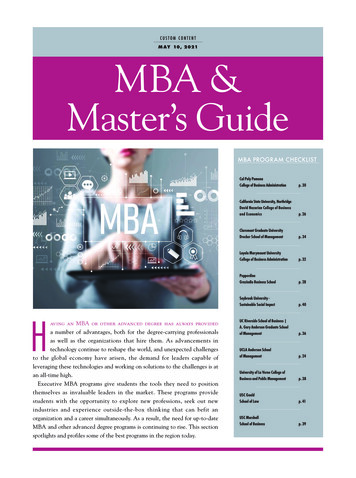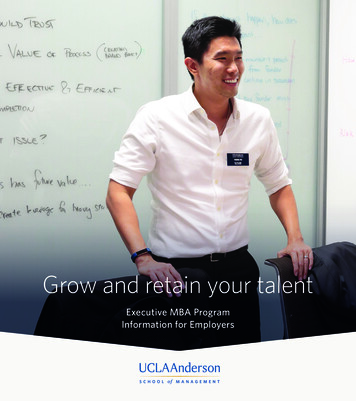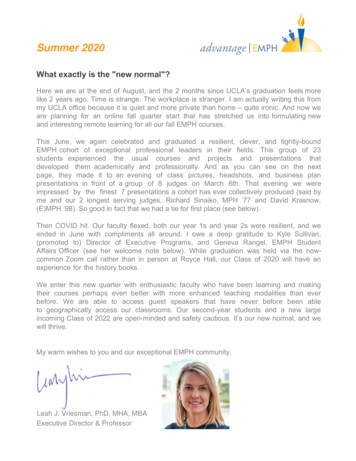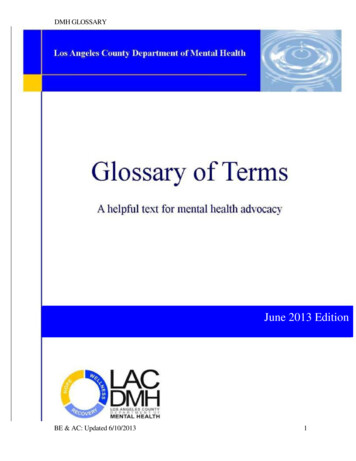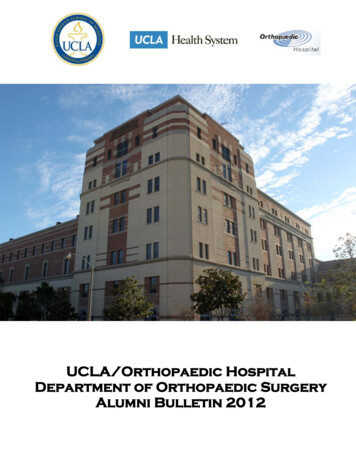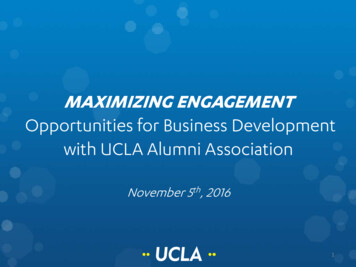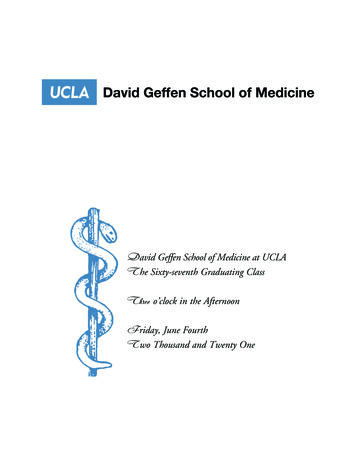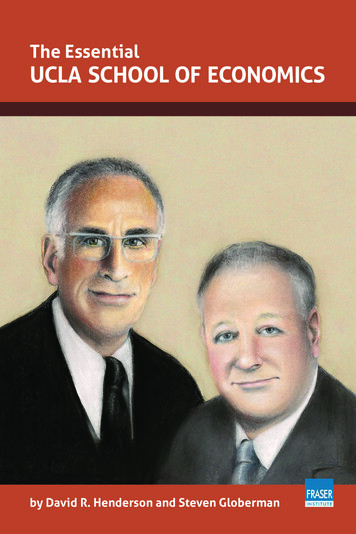
Transcription
The EssentialUCLA SCHOOL OF ECONOMICSby David R. Henderson and Steven Globerman
Fraser Institute d www.fraserinstitute.org
The EssentialUCLA Schoolof Economicsby David R. Hendersonand Steven GlobermanFraser Institutewww.fraserinstitute.org2021
Copyright 2021 by the Fraser Institute. All rights reserved. No part of this bookmay be reproduced in any manner whatsoever without written permission except inthe case of brief quotations embodied in critical articles and reviews.The authors of this publication have worked independently and opinions expressedby them are, therefore, their own, and do not necessarily reflect the opinions ofthe Fraser Institute or its supporters, directors, or staff. This publication in no wayimplies that the Fraser Institute, its directors, or staff are in favour of, or oppose thepassage of, any bill; or that they support or oppose any particular political party orcandidate.Printed and bound in CanadaCover artworkLeslie LightheartISBN 978-0-88975-646-5
Contents1What was the UCLA School? / 12Can Property Rights Help Us Understand People’s Actions and EvenReduce Conflict? / 93How the Profit Motive Reduces Racial and OtherDiscrimination / 234When Do Property Rights Come About? / 295Firms Exist to Solve Problems / 336The Nirvana Approach / 417Does the High Market Share of a Few Companies Imply MarketPower? / 518Regulation: The Economics of Unintended and IntendedConsequences / 639Do Firms Need to Maximize for the Model to Fit? / 7310Can Economies Recover Quickly from Disaster? / 8111Concluding Comments / 89Suggested Readings and References / 93Publishing information / 101About the authors / 102Publisher’s acknowledgments / 103Supporting the Fraser Institute / 103Purpose, funding, and independence / 104About the Fraser Institute / 105Editorial Advisory Board / 106
Fraser Institute d www.fraserinstitute.org
Chapter 1What was the UCLA School?No person or group poses detailed questions of how the community is to useits resources, and no one imposes comprehensive answers to the questions.Yet such problems—large and small—somehow are solved daily. No agencyis appointed to ensure that adequate food reaches every city and is allocatedamong competing claimants—and yet the people eat.— Armen A. Alchian and William R. Allen, University Economics,3rd ed., p. 6.The UCLA School of economic thinking was a strong free-market traditionin late twentieth century economics. Some who observed it from a distancehumorously referred to UCLA as “the University of Chicago at Los Angeles.”In some ways it was almost as strong as the University of Chicago School,whose most notable members in the 1960s and 1970s were Milton Friedman,George Stigler, and Gary Becker. In other ways, the UCLA School was evenstronger. Armen Alchian, in particular, was one of a kind. His relentless application of economic analysis, especially analysis of property rights, was notreplicated anywhere else. In the area of property rights, Harold Demsetz wasa close second. The UCLA School was at its zenith from the mid-1960s tothe late 1980s.The UCLA tradition carries on in the work of dozens of economistswho earned their PhDs at UCLA during its golden years. Also, because thework spread beyond UCLA, the tradition lives on in the work of scores ofeconomists who had no formal connection with UCLA.In this short book, we, who both earned graduate degrees in economics at UCLA during the 1970s (Globerman earned his Masters in 1970and Henderson his PhD in 1976) lay out the most pathbreaking insights thatwww.fraserinstitute.org d Fraser Institute d 1
2 d The Essential UCLA School of Economicsvarious members of the UCLA School had, insights that still influence economics today.The most important economists at UCLA during the 1970s wereArmen Alchian, Harold Demsetz, Sam Peltzman, Benjamin Klein, RobertClower, Alex Leijonhufvud, Jack Hirshleifer, William Allen, and George Hilton.A distinguishing feature of most of the UCLA economists’ contributions is that they were non-mathematical. This was especially notable inan era in which mathematics had almost taken over economics. The majorUCLA School contributors used mainly words and occasionally graphs.Another distinguishing feature is their use of basic economic analysis tounderstand behaviour that had previously not been understood or had evenbeen misunderstood.The most important member of the School was Armen Alchian, whodied in 2013. Alchian taught at UCLA from 1946 until his retirement in 1984.As you will see throughout this volume, Alchian’s insights and writings underlie a distinctive theme of the School’s approach to economics: in most productive activity, the profit motive, combined with private property rights, successfully aligns the interests of producers and consumers, often in subtle ways.As Susan Woodward, a former graduate student of Alchian’s, hasnoted, Alchian had no use for formal models that did not teach us to looksomewhere new in the known world. Nor had he any patience for findingsthat relied on fancy statistical procedures. Alchian saw basic economics as apowerful tool for explaining much of human behaviour in both market andnon-market settings. Much of Alchian’s work was guided by the insight: “Youtell me the rules and I’ll tell you what outcomes to expect.” As Woodward hasnoted, Alchian believed that a huge amount of human behaviour could beunderstood if one got straight what the property rights (i.e., the rules) were.Another major accomplishment of Alchian’s was, in collaborationalong with his long-time UCLA colleague William R. Allen, the undergraduate textbook University Economics. The textbook, the first edition of whichwas published in 1964, was rare in a way that gave it standing in the economics profession: it taught economics not only to undergraduates but also tograduate students and even economics professors. Many graduate studentsand economics professors over the years have reported that they learned moreeconomics from that textbook than from any other single book.Fraser Institute d www.fraserinstitute.org
The Essential UCLA School of Economics d 3Perhaps one quote from a question at the end of a chapter will illustratehow radical (in the sense of going to the root), University Economics was:”Technically speaking, any labor union is a monopoly in the limited sense that it eliminates competition between workingmenfor the available jobs in a particular plant or industry. After all,unions are combinations of workingmen to increase, by concertedeconomic action, their wages, i.e., the price at which the employerwill be able to purchase their labor.” (Arthur Goldberg, Justice,Supreme Court of the United States, and formerly Secretary ofthe Department of Labor and counsel for the United Steelworkers;quoted from AFL-CIO: Labor United, New York, McGraw-Hill,1956, p. 157.) Why did he write “technically speaking” and “inthe limited sense”? Is there some other mode of speaking and isthere an unlimited sense of monopoly? (Alchian and Allen, 1972,3rd edition: 449)And consider this dramatic way of introducing the economic concept of scarcity in the first two sentences of the book’s first chapter:Ever since the fiasco in the Garden of Eden, most of what we getis by sweat, strain, and anxiety. Two villains—nature and otherpeople—prevent us from having all we want. (Alchian and Allen,1972: 3)The second most prominent member of the UCLA School was HaroldDemsetz. Demsetz spent most of his professional life at UCLA and at theUniversity of Chicago. Demsetz made major contributions to the study ofproperty rights and to regulation and antitrust policy. As Sam Peltzman hasnoted, Demsetz fundamentally revolutionized thinking about the prevailing logic underlying antitrust theory. Prior to Demsetz’s work, economistsin the area of what’s called industrial organization were suspicious of bigfirms whose revenues were a large percent of overall industry revenues.Such firms charged above-competitive prices, they claimed, thereby harming consumers and reducing overall economic efficiency. Demsetz arguedthat market concentration could reflect the superior efficiency of firms withwww.fraserinstitute.org d Fraser Institute
4 d The Essential UCLA School of Economicslarge market shares primarily resulting from innovation, and he supportedhis argument with empirical evidence. Government efforts to break up largefirms or restrain their growth was, therefore, likely to reduce innovation andeconomic efficiency, with consequent harm to consumers. Peltzman arguesthat Demsetz’s work fundamentally altered the hitherto mechanical application of legal restrictions on mergers between relatively large firms to a more“rule-of-reason”-based approach, whereby the potential for efficiency gainswas weighed in the balance.The UCLA School was also prominent in the area of economic regulation. Sam Peltzman and George Hilton challenged the conventional wisdomabout the objectives of regulators and the consequences of regulation. Thetraditional economic justification for government regulation of private sectorbusinesses is that regulations are needed to protect consumers against business abuses such as monopoly pricing, cheating on the quality of productssold, the sale of hazardous products, and misleading consumers through falseadvertising claims or by failing to disclose important information such asthe true annual interest rate on an automobile loan. In the idealized view ofregulation, the regulators are informed public-spirited people who work onlyto promote the social good.Peltzman and Hilton debunked this idealized view of regulatory behaviour by documenting how regulators pursue their own interests in carryingout their activities and showing that the interests of regulators are often atodds with the social interest. In particular, regulation often stifles competition, resulting in higher prices.Even when enlisting expert advice, it is extremely difficult for regulators to form a complete and accurate picture of how specific regulations willaffect the behaviour of the many individuals and organizations affected. It isimpossible, for example, for regulators to forecast how new technologies andnew uses of existing technologies will undermine the intent of the regulator.Hilton noted that the regulatory experience is replete with examples of howthe non-competitive price structures imposed by regulators encouraged theuse of new technologies to circumvent, and ultimately render unsustainable,existing regulatory decrees.The UCLA School was at the forefront in documenting that inefficientregulations create incentives to avoid those regulations, which often resultsin new ways of performing the regulated activity, although not necessarilyFraser Institute d www.fraserinstitute.org
The Essential UCLA School of Economics d 5as efficiently as would be the case in the absence of the regulations. It alsodocumented how efforts to protect and perpetuate regulated monopolies contribute to delays in implementing changes that would improve the economicwelfare of large numbers of consumers in order to protect the economic interests of a relatively small number of incumbent producers.For example, Eckert and Hilton (1972) tell the story of electric streetrailways, which were the main form of urban public transportation in theearly 1900s. Most street railways operated one or a small number of lines thatran along main streets and covered a limited area of the city. Furthermore, invirtually every city, the street railway charged a flat 5-cent fare regardless ofthe distance a passenger traveled. The rigid layout of street railways and theimplicit penalty the flat fee imposed on short-haul commuters encouragedthe growth of private jitney services, i.e., individuals who would use their owncars or rented cars to provide transportation services to those who wanted totravel off the main routes covered by the street railways. They also providedfor flexible capacity, as more jitneys were available during peak hours andcharged rates that were responsive to demand conditions, e.g., higher ratesduring peak commuting hours and lower rates during off-peak periods.1In short order, a large number of privately owned automobiles werecompeting with street railways. The railways sought protection from municipal governments against this competition. Municipal governments saw benefits to limiting competition. One benefit was the tax revenues they couldcollect from the monopoly profits earned by regulated street railways thatenjoyed exclusive rights to operate on specific routes. Another benefit wasthat they received political donations and other support from the establishedand relatively well-funded streetcar owners. For those reasons, they grantedprotection from competition. Local governments introduced regulationsdesigned to raise the costs of jitney operators and reduce the flexibility ofthe service they offered. The regulations were especially punitive for shorthaul jitney businesses. The result was that most jitneys were eliminated fairlyquickly. Eckert and Hilton argue that allowing free entry, while ensuring thatjitney operators bore the full costs of their operations, including paying their1Contemporary readers might see a parallel to the rise of companies such as Uber and Lyftin response to the rigidities and relatively high fares that characterize taxicab services in urbancenters.www.fraserinstitute.org d Fraser Institute
6 d The Essential UCLA School of Economicsshare for street repairs, would have saved society decades of unsatisfactoryexperience with inefficient alternatives, including buses that operated in muchthe same way as street railways.The moral of this and similar stories is that regulators cannot extinguish the incentives of market participants to create economic gains for themselves by providing cheaper and/or more convenient goods and services forcustomers, and efforts by regulators to thwart the pursuit of those incentivesperpetuate economic inefficiencies that make society as a whole economically poorer. In particular, many consumers pay more for the relevant goodsand services than they would have paid if markets were deregulated, whileestablished firms often earn higher profits than they would have earned in anunregulated competitive market.An overview of the UCLA School would be incomplete without mention of Benjamin Klein’s work in monetary theory, and Robert Clower andAxel Leijonhufvud’s work in macroeconomics. In the 1970s, Klein was oneof the early economists who took seriously the idea of competing moneysupplies. He also, as will be seen in Chapter 7, contributed path-breakingwork in industrial organization generally and on the economics of the verticalintegration of firms specifically.Leijonhufvud did some early work arguing that most Keynesianshad misinterpreted John Maynard Keynes’s General Theory of Employment,Interest, and Money. In follow-on work, Leijonhufvud and Robert Clowerargued that when existing market prices, especially wages, depart substantially from prices that would equilibrate supply and demand and there arestrong frictions that make this equilibration costly, an economy can remainin disequilibrium for an extended period of time. Leijonhufvud had arguedthat people misinterpreted Keynes’s explanation of less than full-employmentequilibrium as a problem of insufficient aggregate demand rather than a problem of inflexible prices.Not to be missed in a summary of contributions by UCLA economistsis the work of Thomas Sowell. He wrote his 1975 book Race and Economics,a precursor to his much more extensive work on the economics of variousethnic groups, while at UCLA.In the chapters to follow, we discuss more of the specific contributionsof Alchian, Demsetz, Peltzman, Klein, Hilton, and Hirshleifer. We think youFraser Institute d www.fraserinstitute.org
The Essential UCLA School of Economics d 7will find it an exciting excursion through the fundamentals of late twentiethcentury economic thinking.www.fraserinstitute.org d Fraser Institute
8 d Fraser Institute d www.fraserinstitute.org
Chapter 2Can Property Rights Help UsUnderstand People’s Actions andEven Reduce Conflict?One of the most fundamental requirements of a capitalist economic system—and one of the most misunderstood concepts—is a strong system of propertyrights. For decades social critics in the United States and throughout theWestern world have complained that “property” rights too often take precedence over “human” rights, with the result that people are treated unequallyand have unequal opportunities. Inequality exists in any society. But thepurported conflict between property rights and human rights is a mirage.Property rights are human rights.— Armen A. Alchian (2008), “Property Rights,” p. 422.How property rights reduce conflictShould restaurants allow smoking or not? Should schools teach evolution orintelligent design or both? Should insurance companies cover contraception?Should we be able to take off our shoes in your living room?You might think that that last question doesn’t belong with the firstthree. After all, the first three questions are momentous ones about “publicpolicy.” The last one is only about the rules you have for our behaviour in yourliving room—a “private policy” question. And your answer to that questionwill depend on how you want to use your property.But think about what you just read: Your answer to whether we shouldbe able to remove our shoes in your living room depends on how you want touse your property. What is implicit here, but obvious to all, is that the choicewww.fraserinstitute.org d Fraser Institute d 9
10 d The Essential UCLA School of Economicsis yours. We have no say in the matter. That doesn’t mean you won’t takeaccount of our thoughts and feelings. You will. Let’s assume that you find itdistasteful for us to take off our shoes, but that you like our company. Let’sfurther assume that telling us that we can’t get comfortable by taking off ourshoes will mean that we won’t want to visit you. You will then trade off yourdistaste at having us shoeless with the pleasure you take from our company.If one outweighs the other, in your subjective estimation, then you’ll chooseaccordingly.Notice how property rights solve the problem. It’s your living roomand so you get to choose. How your living room gets used is not a publicpolicy problem.Although Armen Alchian and Harold Demsetz never, as far as weknow, used the shoe example, it’s a clear example of the way they reasoned tothe conclusion that well-defined property rights solve problems and createharmony.If property rights are respected, none of the other three questions is apublic policy problem either. Consider each in turn.Should a restaurant allow smoking? We have no idea. Neither do you.Who does? The restaurant owner. The restaurant owner knows that if he banssmoking, he will get more business from non-smokers and less business fromsmokers. He also knows that if he doesn’t ban smoking, he will get more business from smokers and less from non-smokers. He will make that tradeoffand, if he has no particular interest one way or the other, will likely do so in away that maximizes his net income from running a restaurant.But don’t his employees matter? Yes, they do, and the restaurant ownerknows they do and has an incentive to take account of their preferences. Ifhis employees don’t like working where there’s smoke, he will take accountof both the extra wages he must pay to get good employees and the higherturnover of employees. These all factor into his decision. Interestingly, though,a former waitress told one of the authors that even though she doesn’t likesmoke, she and her colleagues had preferred, as waiters and waitresses, towork in restaurants that allowed smoking. Why? Because, she said, peoplewho smoked also had a higher probability of drinking alcohol and, therefore,had higher restaurant tabs and paid bigger tips.In short, whether restaurant owners should allow smoking is not apublic policy problem. It’s a totally private issue, and the person who shouldFraser Institute d www.fraserinstitute.org
The Essential UCLA School of Economics d 11make the decision is the owner. The only reason it looks like a public policyproblem is that the government has made it one—by increasingly putting itsthumb on the scales and forcing restaurants to disallow smoking.A true story about two well-known economists is à propos. RobertBarro, an economics professor at Harvard University, hates smoke. When hewas on the economics faculty at the University of Chicago, at a time whensmoking was allowed, he had a “No smoking” sign on his office door. But that’snot all the sign said. One of Barro’s colleagues at the time was Robert Lucas,a brilliant economist who, in 1995, won the Nobel Prize in Economics. Lucaswas also a heavy smoker. Barro treasured his conversations with Lucas. So,the full text of sign was: “No smoking, except for Bob Lucas.”In other words, Bob Barro traded off his intense dislike of cigarettesmoke for his intense appreciation of his conversations with Bob Lucas. Hemade a judgment about how to use his property—his office—based on thattradeoff. That’s similar to the story about how you would use your living roomif you valued our company but “disvalued” our being shoeless.Consider the question of whether schools should teach evolution orintelligent design or both. Your first instinct might be to say that the answerdepends on which is true: evolution or intelligent design. But what if what oneperson thinks is true is something that another person thinks is false? Somepeople are absolutely sure that evolution is true, while others are absolutelysure that intelligent design explains why we we’re here on planet Earth.But the only reason this appears to be a public policy problem is thatwith a prior intervention, governments have made it one. How so? By taxingpeople, some of whom believe in intelligent design, some of whom believe inevolution, and some of whom don’t know what they believe, to pay for otherpeople’s schooling. In other words, it appears to be a public policy problembecause of a prior restriction of people’s right to keep their own property.That’s why there is conflict. People who argue that they shouldn’t be forcedto subsidize the teaching of intelligent design have a point. So do those whoargue that they shouldn’t be forced to subsidize the teaching of evolution.Thomas Jefferson put it best: “To compel a man to furnish contributions ofmoney for the propagation of opinions which he disbelieves and abhors issinful and tyrannical.”If the government got out of schooling and let people choose how andwhere to spend their money on their children’s schools and on other children’swww.fraserinstitute.org d Fraser Institute
12 d The Essential UCLA School of Economicsschools (we are assuming that, consistent with history, many relatively affluent people who are free to choose how to spend their money would willinglysubsidize the schooling of those who are less affluent),2 the problem wouldgo away. Those who want to finance the teaching of evolution would do so;those who want to finance the teaching of intelligent design would do so. Theconflict would disappear.Of course, there would still be people who are upset that a schoolteaches something they disapprove of, but that doesn’t mean that there wouldbe conflict. If everyone’s property rights were respected, there would be noconflict. There would simply be people who are upset by others’ choices.Consider, finally, a hot-button issue that came up in the United Statesduring the last decade: Should insurance companies cover contraception?That’s for each individual insurance company to decide. In making that decision, will they consider the interests of their customers? Absolutely. It’s inthe insurance companies’ interest to do so. How will they think about it?Companies whose owners or managers think it’s immoral to cover contraception probably will not cover contraception. They have the right not to doso and their rights should be respected. Most companies will probably thinkabout it the standard way they think about these things: How much are customers willing to pay to get coverage for contraceptives? And how much willit cost the insurance company to provide such coverage, taking account of thefact that covering contraception might save the insurance company moneythat it would have spent on abortions and on pregnancies brought to term?The insurance companies probably have a lot of information on these issues.We can tell them little that they haven’t thought of. But it’s not a public policyissue unless the government makes it one. It’s a matter for the insurance company to decide. Then customers can decide whether to deal with that company.This is just a small list of the problems that are apparently “publicpolicy” problems only because the government has chosen to make them so.Private property solves people’s problems every day.32 For a look at how schooling was almost universally provided in England in the mid-nineteenthcentury (when almost everyone was much poorer than people are today and there was virtuallyno government involvement), see West (1965/1994).3 This section is adapted from Henderson (2012).Fraser Institute d www.fraserinstitute.org
The Essential UCLA School of Economics d 13Using property rights to explain behaviourProperty rights are the core concept underlying most of the major intellectual contributions of the UCLA School. In particular, Alchian, Demsetz, andothers emphasized how the existence and strength of private property rightsaffect economic behaviour.Walter Williams (2018), a widely published author and professor whostudied under Armen Alchian, stated that private property rights containthree components: (1) the owners’ rights to make decisions about the usesof their own property; (2) their right to keep and dispose of their property;and (3) their right to enjoy the income, as well as bear the losses, resultingfrom their decisions. Alchian (1965) defines a system of property rights as amethod of assigning to particular individuals the authority to select, for thegoods or services owned, any use from a non-prohibited set of uses. Havinga property right, therefore, means that the owner enjoys protection againstother people acting against the owner’s will.Consider an example that most of us take for granted but that illuminates the point. You regularly take your nice clothing to a dry cleaner thatyou have come to trust. One day, you go to pick up your best shirt, which youhad bought for 100 just a few weeks earlier. Your tag says the dry cleaner hasthe shirt, but the employee can’t find the shirt. You ask for 100 in cash sothat you can buy a new shirt. The employee refuses. What do you do? We allknow the answer. You ask to speak to the manager. But why do you do that?Because the manager has more power over the decision to reimburse thanthe employee below her has. Chances are that the manager will give you the 100. But what happens in the unusual case that she doesn’t? You then saythe magic seven words: “I need to talk to the owner.” We all understand, evenif only at an intuitive level, why those are the key words. But an understanding of property rights helps us move beyond intuition to a clear theoreticalunderstanding. The reason to talk to the owner is that the owner has the mostto gain by keeping his reputation intact or to lose by not being accountableto the customer. The owner is what Alchian calls the “residual value claimant.” Economists have shortened the term to “residual claimant.” The owneris the residual claimant because he gets all the difference between revenuesand costs. This gives him an incentive to care strongly not only about currentrevenues and costs but also about future revenues and costs.www.fraserinstitute.org d Fraser Institute
14 d The Essential UCLA School of EconomicsAlchian (1965) used this focus on property rights to explain the difference between a privately-run and a government-run enterprise. He gavethe example of garbage collection. A government bureaucrat is not a residualclaimant. If he inefficiently manages a municipally owned garbage collectionservice, he suffers no direct financial loss other than possibly being fired. Butbecause he is a government official working for a government agency, his bossor bosses, who are also government officials, don’t have a strong incentive tofire him. His and his bosses’ actions would have to be so egregious that voters demand that their elected officials fire him. But this threat is likely to bemuch less effective than that faced by the owner of a privately-owned servicewho would suffer substantial and direct financial losses if the city terminatedits contract for the service. And the incentive for good performance wouldbe even stronger if garbage collection companies sold their services directlyto customers. In other words, efficient performance is more likely when theproperty right to the rewards for efficient garbage collection is held privatelyrather than held collectively by a municipal government.In University Economics, Alchian and co-author Willam R. Allen usedproperty rights to explain the underpricing of tickets to the Rose Bowl. Theynoted that every year there is a large shortage of tickets to this event. Manypeople who want them at the face price can’t get them. Why does that happen? At the time they wrote, the Rose Festival Association, which sold thetickets, was not privately owned. One third of the ticket receipts went to theassociation and one third went to each of the participating universities andtheir athletic conferences. But, they noted, “no person can claim any pro ratapart of the proceeds as being ‘his.’”This simple fact, they noted, had huge implications. Why should thedecision-makers price higher to reduce or eliminate the shortage when they
Aug 29, 2000 · The UCLA School of economic thinking was a strong free-market tradition in late twentieth century economics. Some who observed it from a distance humorously referred to UCLA as “the University of Chicago at Los Angeles.” In some ways it
